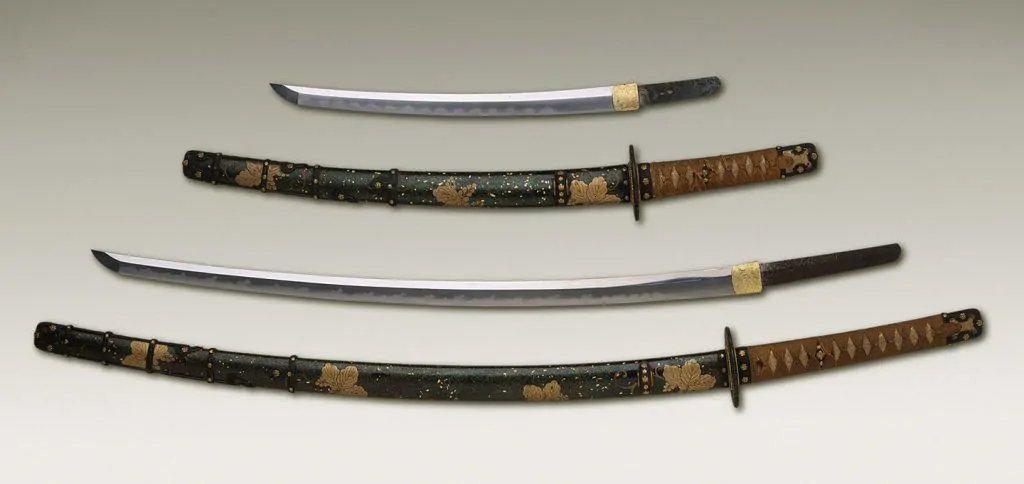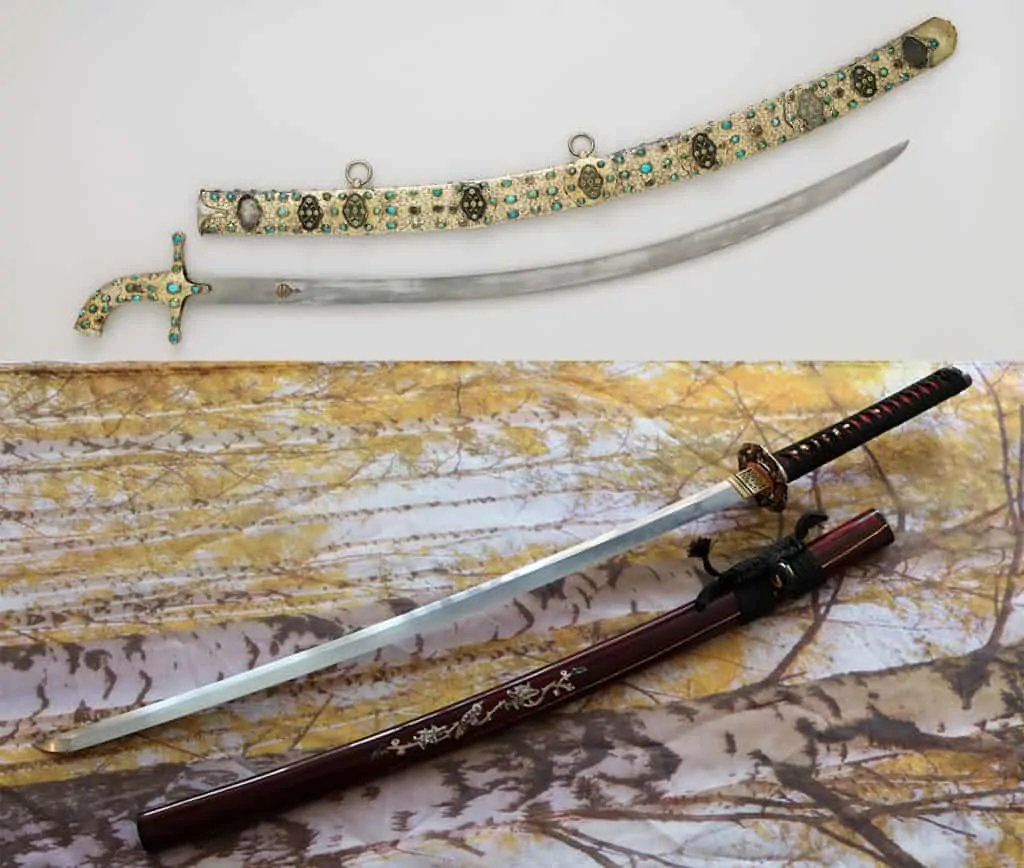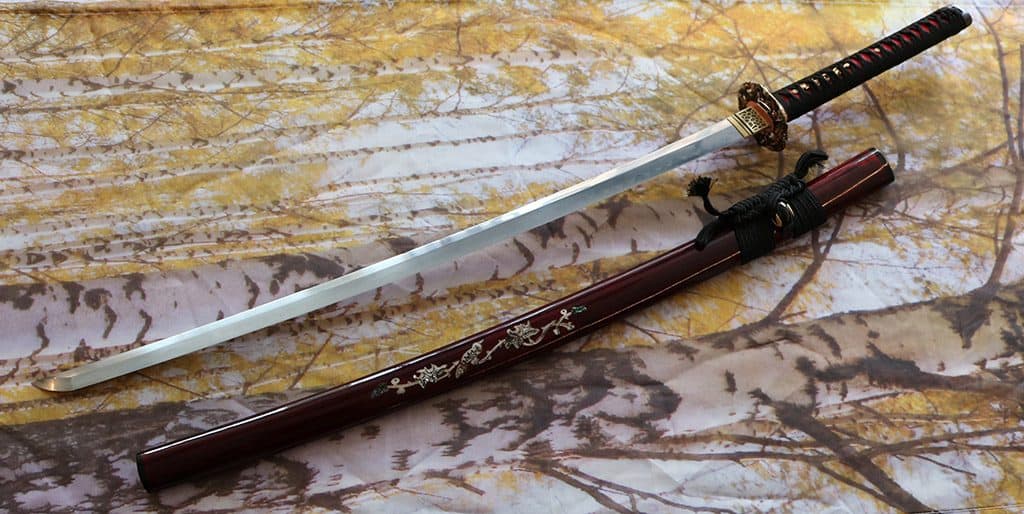
Have you ever wondered why katanas have a curve?
What if I tell you that during the forging process the blade actually is straight.
You don’t believe me? Let’s check out the reasons for katana curvature together.
Table of Contents
Reasons for katana curvature
Actually, there is only one reason why katanas are curved.
Just a few minutes ago I read a few forum posts about katana curvature.
It makes me angry that people are sharing incorrect information on this topic all the time.
Exactly this is the reason why I created this blog post. The katana isn’t curved in order to optimize it’s cutting abilities.
The curve on a katana is so slight I consider it to be more similar to a straight blade than a curved blade.
The curvature of a katana is approximately 1.5 cm (0.6 in) and called Sori in Japanese.
For this reason, katanas don’t cut better than straight swords nor can be drawn quicker from the saya (scabbard).
However, most forums (and other bloggers) claim that this is the case.
I can’t really blame them, as this info I am going to share with you is quite unknown to most people.
Remember, at the start of this post I told you that katanas are still straight blades during the forging process.
They get their curve from the tempering process. Almost all katanas are clay tempered.
During this process, the spine of the blade gets covered with clay.
Therefore, the spine remains soft, while the edge gets very hard.
After the heat treatment, the Japanese sword gets quenched.
Due to the clay, the edge cools much faster than the spine. Thus, becoming harder.
The hard edge expands as the metal becomes hardened steel. The spine does not expand so much, curving the formerly straight blade.
Let’s sum this up again in one sentence:
The curvature of a katana comes from the quenching process, as the blade is differentially hardened.
Benefits of katana curvature
I could talk about the forum posts in this section again.
Presumably, you already know what I want to say. :D
In contrast to the popular opinion, I am certain that the slight curve of the katana has NO effect on its properties.
There is nothing a katana can do better than a medieval sword (at least regarding curvature).
However, let’s address some of the common statements we hear on katana curvature.
Thesis 1: The curve makes cuts more lethal
This is probably the most common misconception about the katana curve.
Curvature might be an advantage if the katana wasn’t so slightly curved. Middle Eastern swords like the heavily curved scimitar certainly got an edge over a straight sword.

The curve of the katana is just too slight.
Let me tell you the main reason why people assume that curvature increases the performance of the katana.
This is mostly due to the fact that with a curved blade less of the katana’s edge touches the target.
Thus, the same force is distributed among a smaller surface area. Therefore, the strike will be more harmful.
Most of these tests are done on completely rectangular objects. The curve of the katana decreases the surface that touches the target by around 1 cm (0.4 in).
However, no human is anywhere near rectangular. Performing the same test on a more human-like object, resulting in the katana having no advantage over a straight blade.
Whereas the curvature of a scimitar certainly helps build up more force.
Thesis 2: The curve makes drawing the sword easier
In theory, the wielder is able to draw his katana faster, because of its curvature.
It aligns with the drawing motion and makes cutting while drawing possible. The Japanese also came up with a word for this called Nukitsuke.
However, this the curvature of the katana plays no role in this process. This is just a huge myth!
Cutting while drawing is also possible with a straight blade. The factor that influences this point the most is the skill of the samurai.
Nukitsuke was an art. The samurai perfected this technique in order to quickly obliterate of their enemies.
Thesis 3: The curve makes the sword look better

Actually, I never heard anyone say this, but it is completely true!
You don’t believe me? Just look at a medieval longsword and compare it to my katana. Which one looks better?
My katana of course. I personally know no one that thinks that a longsword looks better.
Remember it is not about what you LIKE better. Even if you are a knight fan you have to admit that a katana looks prettier.
This is due to the reason that humans possess a subconscious feeling of what looks right and what doesn’t.
Take a look at a single-edged straight sword. Focus on the tip of the blade.
The tip points upwards right? Exactly this is the case (and the problem). The blade is straight, but the point moves upwards.
These two different movements confuse our brain. As a consequence, it doesn’t look as pleasing for the eyes.
Now let’s move on to the katana. Same game. The tip points upwards. However, because of the curvature the blade moves in the direction the kissaki (point) is facing.
Due to this we subconsciously think that the katana looks better than a regular straight blade.
I haven’t had the time to interview many more people on this topic. I would really appreciate sharing your opinion in the comments. (or disagree).
Conclusion
Yeah, I always like to give a quick summary at the end of my posts.
In comparison to Middle Eastern swords, the katana only has a very slight curve. The curvature of a katana is more similar to a medieval sword than to a scimitar for example.
The curvature of the katana is too slight to be advantageous. However, no one can deny that the curvature is a big enhancement of the katana’s aesthetics.